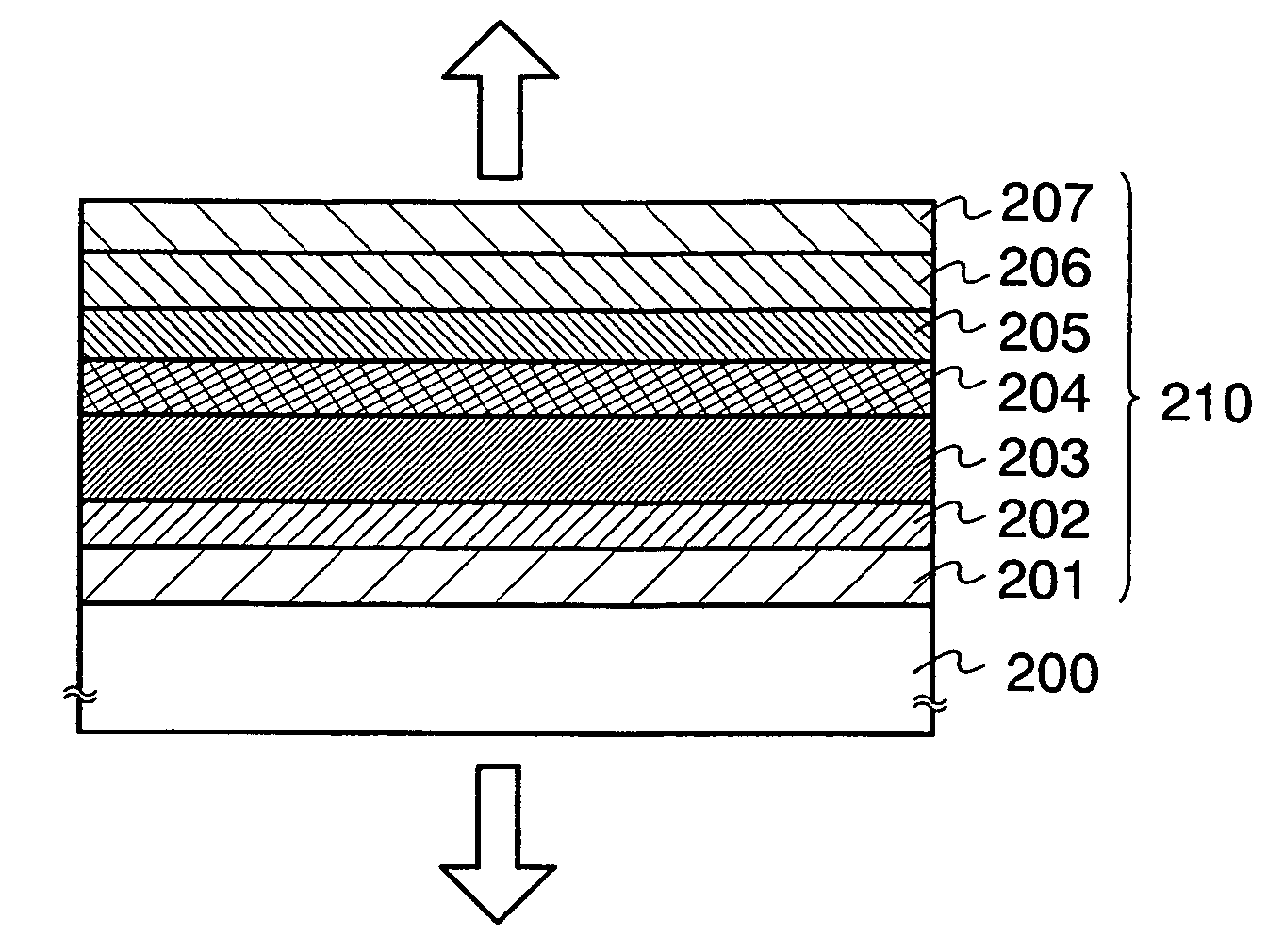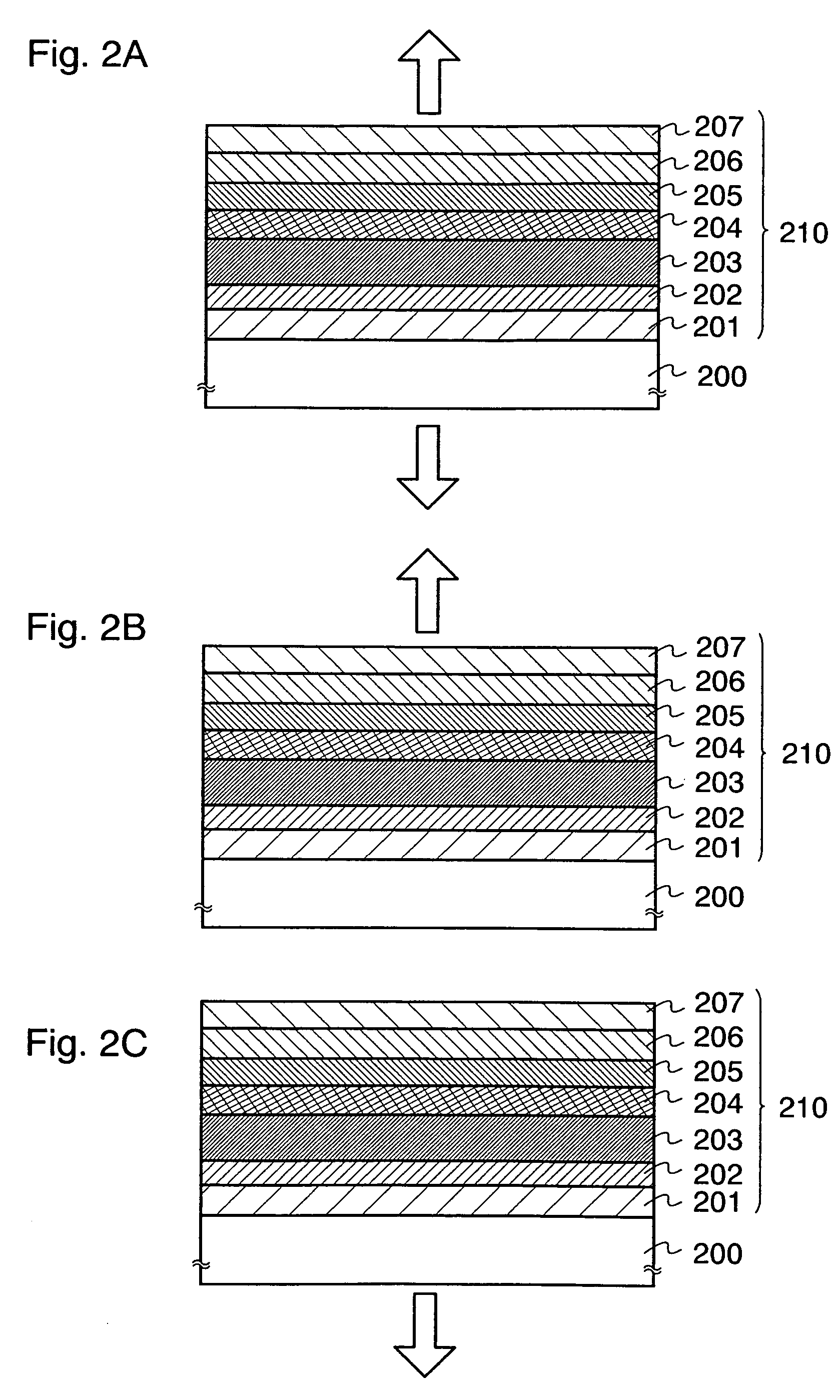Light emitting element and manufacturing method thereof, and light emitting device using the light emitting element
a technology manufacturing methods, applied in the field of light emitting elements, can solve the problems of reducing the external extraction efficiency of emitted light, unable to obtain favorable characteristics, and unable to achieve luminous efficiency in red light emission, etc., and achieves the effect of suppressing the short circuit between electrodes
- Summary
- Abstract
- Description
- Claims
- Application Information
AI Technical Summary
Benefits of technology
Problems solved by technology
Method used
Image
Examples
embodiment 1
[0063]A manufacturing method of a light-emitting element according to the present invention and characteristics of the light-emitting element will be described. The structure or manufacturing process of the light-emitting element according to the present invention is not limited to the present embodiment, and a film thickness or a material, for example, may be changed appropriately.
[0064]On a glass substrate, indium tin oxide (ITO) is deposited by sputtering to form a first electrode, where ITO in the deposition contains an amorphous component as its main component. Next, after etching ITO to be separated into elements, a heat treatment is performed at 200° C. for 1 hour. Further, after applying an acrylic that is a positive type photoresist, exposure and development are performed to form a partition layer. After that, a heat treatment is performed at 220° C. for 1 hour.
[0065]Next, after wet cleaning, the glass substrate with ITO deposited is processed at 150° C. for 30 minutes in a...
embodiment 2
[0078]In the present embodiment, a light-emitting element that has the same structure as that shown in Embodiment 1 except that the fifth layer including molybdenum oxide has a different film thickness form that in Embodiment 1 will be described. A manufacturing method of the light-emitting element shown in the present embodiment is also the same as that in Embodiment 1. Therefore, descriptions of the manufacturing method are omitted.
[0079]As for the light-emitting element of the present embodiment, the fifth layer including molybdenum oxide has film thicknesses of 10 nm (Embodiment 2-1), 100 nm (Embodiment 2-2), and 200 nm (Embodiment 2-3).
[0080]Characteristics of the light-emitting elements of the present embodiment are shown in FIG. 6. FIG. 6 shows voltage-luminance characteristics, where a horizontal axis indicates a voltage (V) and a vertical axis indicates a luminance (cd / m2). FIG. 6 indicates that a driving voltage (a voltage at which a light emission of 1 cd / m2 or more is st...
embodiment 3
[0082]In the present embodiment, a structure of a light-emitting device according to the present invention will be described.
[0083]In each of FIGS. 9A to 9C, a portion surrounded by a dotted line is a transistor 11 provided for driving a light-emitting element 12. The light-emitting element 12 is formed to include a first electrode 13, a second electrode 14, and a light-emitting layer 15 interposed between these electrodes. The first electrode 13 and a drain of the transistor 11 are electrically connected to each other by a wiring 17 running through a first interlayer insulating film 16a to 16c. In addition, the light-emitting element 12 is separated by a partition layer 18 from another light-emitting element provided adjacently. A light-emitting device that has this structure according to the present invention is provided over substrate 10.
[0084]In the light-emitting device that has the structure described above, the light-emitting element 12 is a light-emitting element according t...
PUM
 Login to View More
Login to View More Abstract
Description
Claims
Application Information
 Login to View More
Login to View More - R&D
- Intellectual Property
- Life Sciences
- Materials
- Tech Scout
- Unparalleled Data Quality
- Higher Quality Content
- 60% Fewer Hallucinations
Browse by: Latest US Patents, China's latest patents, Technical Efficacy Thesaurus, Application Domain, Technology Topic, Popular Technical Reports.
© 2025 PatSnap. All rights reserved.Legal|Privacy policy|Modern Slavery Act Transparency Statement|Sitemap|About US| Contact US: help@patsnap.com



